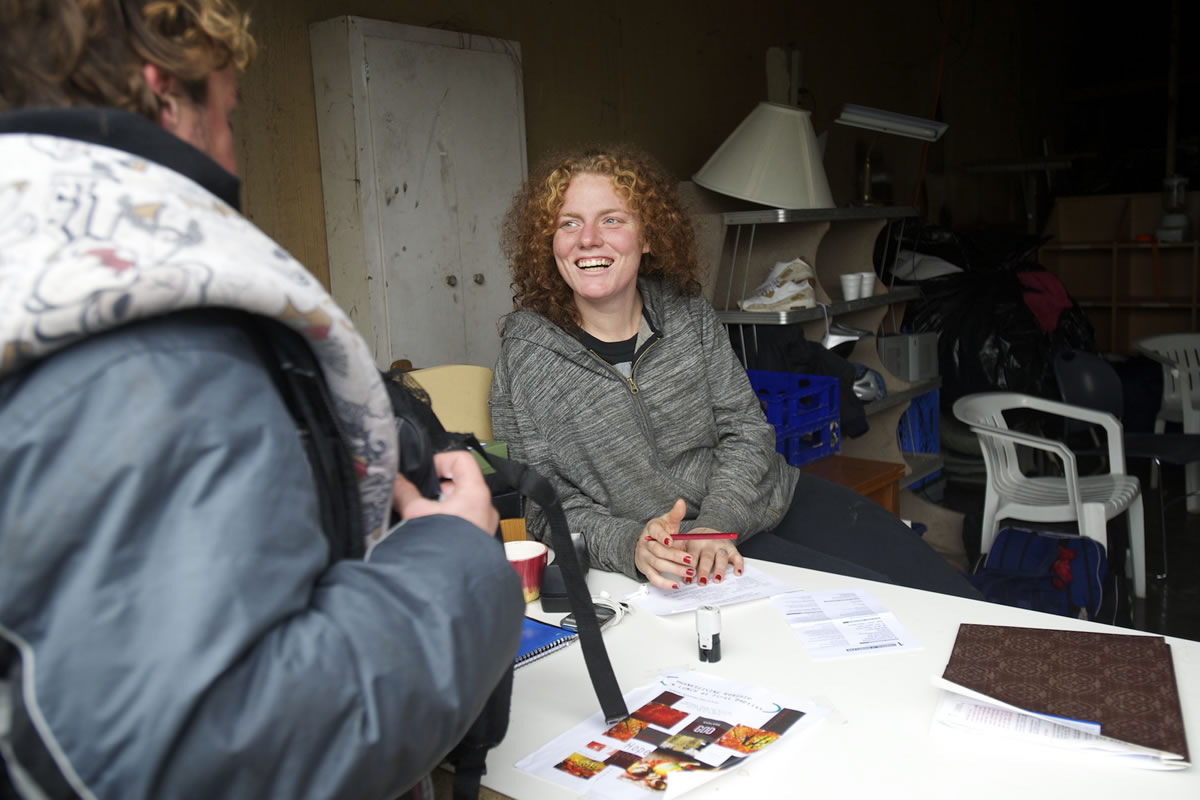Booked into the Clark County Jail seven times this year, racking up a total of 152 days behind bars, Jessica Stewart is used to the drill.
The dozens of questions asked during the booking process. The strip search before she’s issued jail clothes and plastic shoes. The long hours and sometimes days spent in a detox area before she’s clean enough to be assigned to a cell block.
“I usually would go to jail, and I would get a break from my homeless, pathetic life,” she said.
She said that the routine, however, is getting old.
Which is why Stewart, 25, was elated when she was chosen to be part of a new program at the jail aimed at helping inmates like her who want to be helped.
“How do you break that cycle? It’s what I’m trying to figure out,” Stewart said.
A way out
The Re-Entry Program, which is still in its early stages, is designed to connect inmates with community resources to help them tackle the root of their criminal behavior.
Jail Chief Ric Bishop said there are some at the jail who are looking to move past the revolving door of the criminal justice system.
“If someone doesn’t want to change, we can’t waste tax dollars on them,” Bishop said. “We’ll offer (inmates) the tools. It’s up to them to pick them up and go.”
Stewart, it appeared, wanted help.
Before her release in mid-September, she was approached by Corrections Deputy Barbara Schubach.
“She asked me, ‘What are you going to do this time?’ ” Stewart said. “I looked around and said, ‘I don’t know.’ ”
So the two talked. Stewart, who grew up in Vancouver, opened up about her history with methamphetamine that started when she was 13. She explained how her addiction had led her to losing contact with her mother and her 9-year-old daughter. Stewart said meth is the reason she’s been homeless the past three years. Her jail stays over the years include drug, burglary and trespassing offenses.
Sheriff Garry Lucas had recently announced the Re-Entry Program’s launch, and the jail staff chose Stewart as a “pilot” inmate to see what sort of resources are available for someone newly released.
So Schubach went to work. She set up an itinerary that included the Department of Social and Health Services to get set up with food stamps, the Council for the Homeless for an assessment on various needs and FISH for an emergency food box.
When Stewart was released on Sept. 13, Schubach spent the day — nine hours — driving Stewart from place to place.
“It was extremely eye-opening,” Schubach said. “When we release the inmates, you think they go and do the things they need to do. I’m surprised at how much they need to do to get their lives on track.”
Randy Tangen, the Re-Entry Program’s sergeant at the jail, said the goal of the day was to see what challenges newly released inmates face.
“Barb’s experience with (Stewart) was more or less a study to see just what ‘re-entry’ in the most literal sense looks like,” Tangen said. “The best way to do that is to stand beside them while they go through the process of re-entering the community.”
Helping inmates connect to community resources is something that corrections deputies, including Schubach, had been doing informally for some time. But, Tangen said, the Re-Entry Program is a full and concerted effort.
The sheriff’s office doesn’t have the resources to hold the hand of every offender who is released, Tangen said. But helping Stewart made one thing clear: to truly help offenders, the process needs to start while they’re still in custody.
H-Pod
To get that momentum started behind bars, the jail is converting a previously empty pod into a place where those in the Re-Entry Program can meet with representatives of nonprofits and social services.
Starting in January, inmates in the program will be housed in H-Pod, a part of the jail that is set up more as a dormitory with bunk beds in open rooms instead of cells.
Three of the four dorm-style rooms will house inmates, but the fourth room of the pod is being transformed into a multipurpose room that will include tables and office partitions for meetings, classes and interviews.
“We’re engaging people on these root-cause issues,” Tangen said.
He has already been connecting with agencies including the Clark County Department of Community Services, which works on issues such as chemical dependency and collaborates with other agencies on homelessness. Tangen has also been working with Goodwill, which has employment programs in place.
When brainstorming the program, the Clark County Sheriff’s Office consulted with staff at the Multnomah County Jail in Portland, which already has a re-entry program in place.
“It’s very much a nationwide trend leaning heavily toward re-entry,” Tangen said.
Chief Bishop describes the program as part of a cultural shift at the jail. The entire department was renamed from Custody to Corrections at the beginning of 2013.
“The staff suggested some of the changes, it’s been a team effort,” Bishop said.
Having worked as a corrections deputy for 19 years, Schubach said she is excited about the shift and the Re-Entry Program.
“This is what we’ve been needing,” she said. “Inmates, those who are aware of it, they want to be part of the program. It is offering something to them that they didn’t have before — and that’s support.”
Looking ahead
Since her day with Shubach, Stewart has gone back to jail twice. After her first release, she was stopped by a Portland police officer and she told him about the warrant out for her arrest and that she had a meth pipe with her. The second time she was released, she relapsed within a few days. When she went to her regular meeting with her probation officer, she admitted her failure.
“If you keep your mouth shut, you can’t get help,” she said. “Methamphetamine, it’s my demon. It’s my dark cloud.”
Stewart said that she broke up with her boyfriend, who still uses drugs, and disassociated with drug users.
“I just had to do some things in my personal life before I could take the steps that (Schubach) had set up for me,” Stewart said. “Even though I failed, I finally took a big step for myself. … I had never asked for help before.”
She has slept under the Interstate 5 Bridge near the Marshall Community Center at night but has been looking into the various shelters. She sought housing from Grace Ministries and The Xchange but her application has not been completed.
After her most recent release on Nov. 14, she went to Giving Grace Ministries, another organization, and asked to help. Steve Young, who runs the daytime resource center for homeless people, told her she can volunteer, which she did for a few weeks, Young said.
A big motivator to stay sober is seeing her 9-year-old daughter — who lives with the girl’s dad. Another thing driving her, she said, is that she wants to set an example for other offenders who also struggle.
“I want to say: I finally did it,” Stewart said. “I want to be the example that everyone can look up to. … I want to see more people turn their life around like I’m starting to.”





